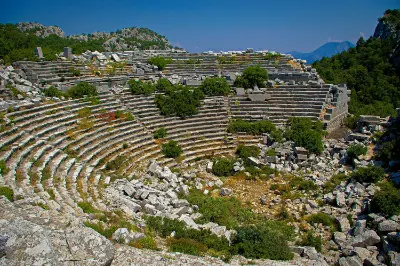Aspendos

Welcome to the Roman Theatre of Aspendos
🏛️ Aspendos: the eternal theatre of Pamphylia
📍 Location
- Located near the town of Serik, in the province ofAntalya, in the south of Turkey.
- The theatre is located at the foot of a hill, in a fertile plain crossed by the river Köprüçay (formerly Eurymedon), which connected the city to the ancient port.
🧬 Origins and construction
- Built between 155 and 180 AD, under the reign of Marcus Aurelius, by the architect Zeno, son of Theodore of Aspendos.
- It was dedicated to the city gods and to the Roman imperial family, a symbol of prosperity and loyalty to Rome.
- Its exceptional conservation is due to its reuse as a caravanserai by the Seljuks in the Middle Ages.
🏟️ Architectural features
- Capacity: approximately 15,000 spectators, spread over a hemicycle of stone steps.
- Monumental stage facade : two floors of niches, Corinthian columns and bas-reliefs, beautifully carved.
- Circular Orchestra 24 meters in diameter, with acoustics so perfect that a whisper in the center is audible up to the upper tiers.
- The rear wall is topped with perforated consoles who supported the velum, stretched canvas to protect spectators from the sun.
🎭 Function and cultural life
- The theater hosted plays, the concerts, the public games, and the civic ceremonies.
- Today it is still used for opera and ballet festivals, including the famous Aspendos International Opera and Ballet Festival, which brings places back to life under the stars.
🌄 Why Aspendos is unforgettable
It is a place where Roman ingenuity reaches its peak, where each stone still seems to vibrate with the voices of actors and ancient applause, and where the past dialogues with the present in perfect harmony. Aspendos is grand, vibrant and deeply inspiring — a timeless masterpiece in the heart of Anatolia.
Continue to Termessos
The site of Termessos is located at an altitude of approximately 1,050 meters. Its design is remarkable at this altitude. It is also a rare city that Alexander the Great was unable to capture in 334 BC; he abandoned it and burned all the surrounding olive trees in revenge.








